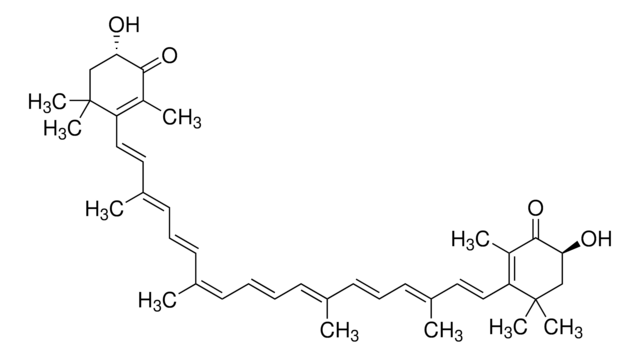41659
all-trans-Astaxanthin
analytical standard
Synonym(s):
Astaxanthin, (3S,3′S,all-trans)-3,3′-Dihydroxy-β,β-carotene-4,4′-dione, (3S,3′S)-3,3′-Dihydroxy-β,β-carotene-4,4′-dione
About This Item
Recommended Products
grade
analytical standard
Quality Level
Assay
≥97%
shelf life
limited shelf life, expiry date on the label
technique(s)
HPLC: suitable
gas chromatography (GC): suitable
application(s)
cleaning products
cosmetics
food and beverages
personal care
format
neat
storage temp.
−20°C
SMILES string
CC1=C(/C=C/C(C)=C/C=C/C(C)=C/C=C/C=C(C)/C=C/C=C(C)/C=C/C2=C(C)C([C@@H](O)CC2(C)C)=O)C(C)(C)C[C@H](O)C1=O
InChI
1S/C40H52O4/c1-27(17-13-19-29(3)21-23-33-31(5)37(43)35(41)25-39(33,7)8)15-11-12-16-28(2)18-14-20-30(4)22-24-34-32(6)38(44)36(42)26-40(34,9)10/h11-24,35-36,41-42H,25-26H2,1-10H3/b12-11+,17-13+,18-14+,23-21+,24-22+,27-15+,28-16+,29-19+,30-20+/t35-,36-/m0/s1
InChI key
MQZIGYBFDRPAKN-UWFIBFSHSA-N
Looking for similar products? Visit Product Comparison Guide
General description
Application
- Microalgae (Green algae), Haematococcus pluvialis using high-performance liquid chromatography (HPLC) with mass spectrometric and fluorescence detection (HPLC-FLD).
- Parapenaeopsis hardwickii using high-performance liquid chromatography (HPLC) with photodiode array detection (PDA).
Biochem/physiol Actions
Packaging
Storage Class Code
11 - Combustible Solids
WGK
WGK 3
Flash Point(F)
Not applicable
Flash Point(C)
Not applicable
Personal Protective Equipment
Choose from one of the most recent versions:
Already Own This Product?
Find documentation for the products that you have recently purchased in the Document Library.
Customers Also Viewed
Our team of scientists has experience in all areas of research including Life Science, Material Science, Chemical Synthesis, Chromatography, Analytical and many others.
Contact Technical Service












